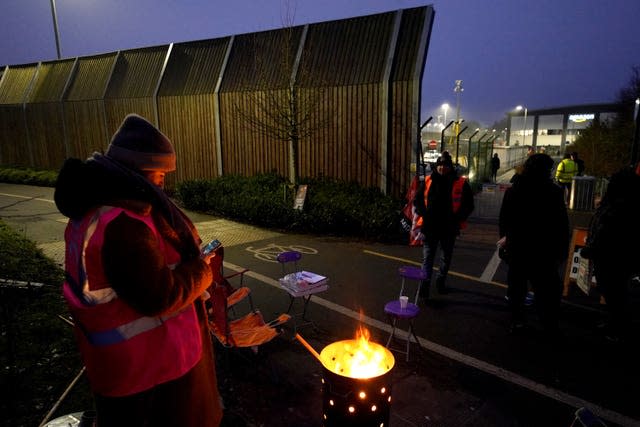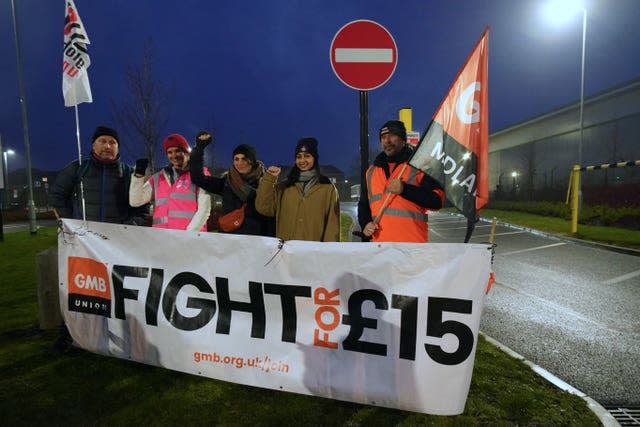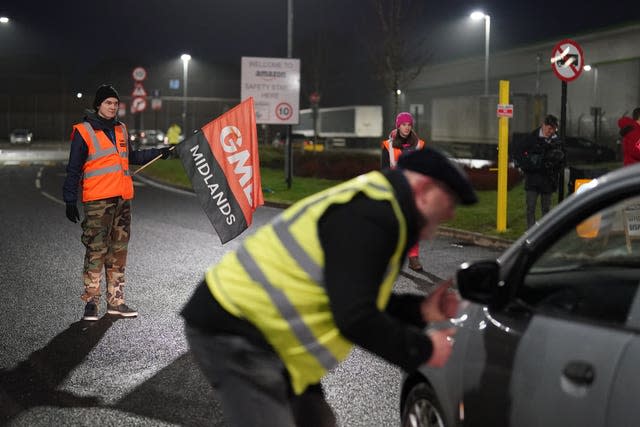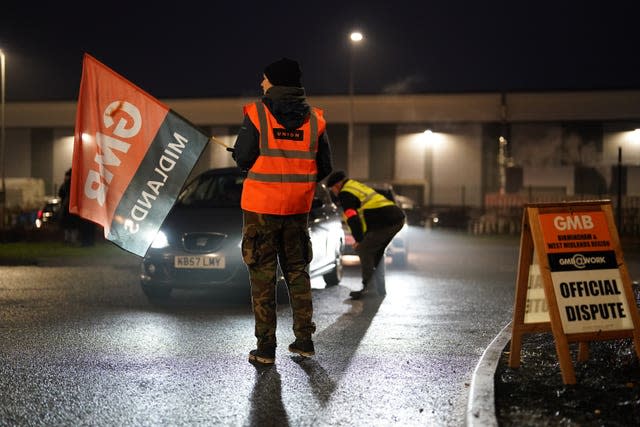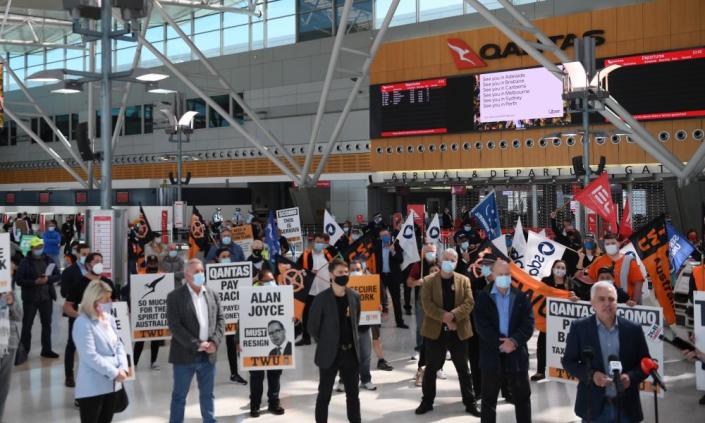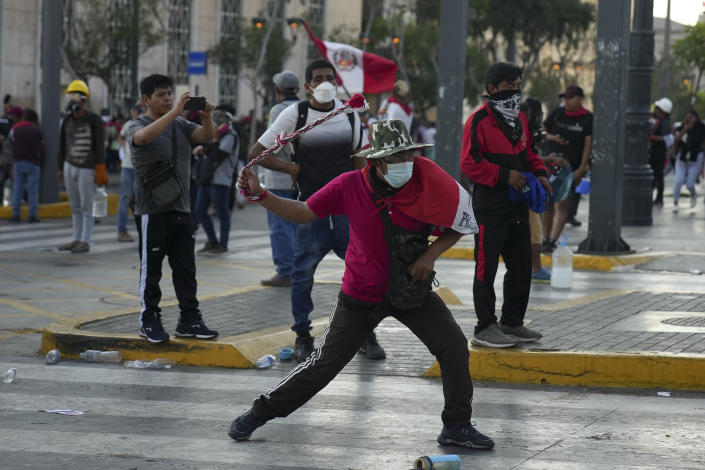
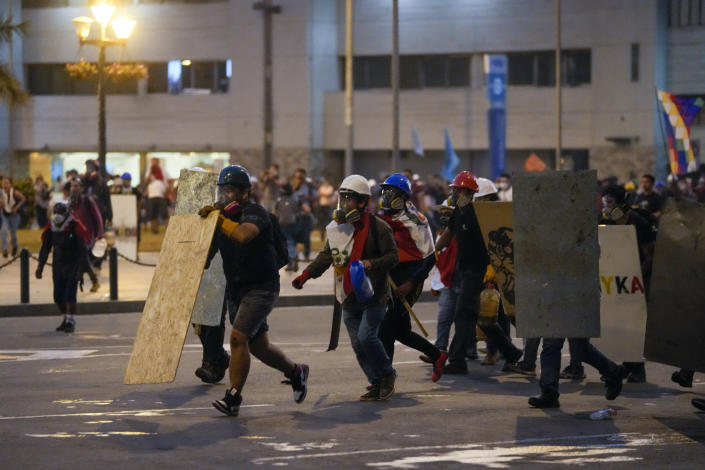
1 / 17
Anti-government protesters clash with police in Lima, Peru, Tuesday, Jan. 24, 2023. Protesters are seeking the resignation of President Dina Boluarte, the release from prison of ousted President Pedro Castillo, immediate elections and justice for demonstrators killed in clashes with police.
DANIEL POLITI
Tue, January 24, 2023
LIMA, Peru (AP) — Thousands of protesters took to the streets of Peru's capital and were met with volleys of tear gas and pellets amid clashes with security forces just hours after President Dina Boluarte called for a “truce” in almost two months of protests.
The antigovernment protest Tuesday was the largest – and most violent — since last Thursday, when large groups of people, many from remote Andean regions, descended on the capital to demand Boluarte’s resignation, immediate elections and the dissolution of Congress.
“We can’t have a truce when she doesn’t’ tell the truth,” Blanca España Mesa, 48, said of Peru's president. Even though her eyes were watering from the tear gas, España Mesa said she was “happy because a lot of people came today. It’s as if people have woken up.”
Before last week, most of the large antigovernment protests that followed the ouster of President Pedro Castillo took place in remote regions of Peru, largely in the country’s south, exposing deep division between residents of the capital and the long-neglected countryside.
The crisis that has sparked Peru’s worst political violence in more than two decades began when Castillo, Peru’s first leader from a rural Andean background, tried to short-circuit the third impeachment proceeding of his young administration by ordering Congress dissolved on Dec. 7. Lawmakers impeached him instead, the national police arrested him before he could find sanctuary and Boluarte, who was his vice president, was sworn in.
Since then, 56 people have died amid the unrest involving Castillo's supporters, 45 of whom died in direct clashes with security forces, according to Peru’s ombudsman. None of the deaths have been in Lima.
On Tuesday, police fired round after round of tear gas as they blocked the passage of protesters, who seemed more organized than before. The smell of tear gas permeated the air and could be felt even a block away as people leaving work suddenly had to cover their faces to try to diminish the sting.
“Murderers,” yelled the protesters, some of whom threw rocks at the police.
Even after most of the protesters had left, police continued firing tear gas to disperse small groups of people in a plaza in front of the country’s Supreme Court.
“I have a right to protest in this country,” Emiliano Merino, 60, said as he was being treated by volunteer paramedics after pellets grazed each of his arms.
Boluarte had earlier called for a truce and blamed protesters for the political violence that has engulfed the country, claiming in a news conference that illegal miners, drug traffickers and smugglers formed a “paramilitary force” to seek chaos for political gain. She said numerous road blockades across the country and damage to infrastructure have cost the country more than $1 billion in lost production.
She suggested that the protesters who died with bullet wounds were shot by other demonstrators, claiming investigations will show their injuries are incompatible with the weapons officers carry. And meanwhile, some 90 police officers are hospitalized with bruises, she said: “What about their human rights?” the president asked.
The government has not presented evidence that any of the injured officers were struck by gunfire.
Human rights advocates say they are dismayed by the lack of international outcry from the regional and global community and are calling for condemnation of the state violence unleashed since Castillo’s impeachment.
Jennie Dador, executive secretary of Peru’s National Human Rights Coordinator, said the lack of international response makes it feel like “we’re alone.”
“None of the states in the region have done anything concrete,” she said.
Boluarte was notably absent from a meeting of regional leaders Tuesday in Argentina’s capital, where most avoided mention of the civilian deaths in Peru.
Human rights activists have acknowledged acts of violence by some protesters — including efforts to take over airports and burn police stations — but say the demonstrations have largely been peaceful.
Some of the leaders at the summit of the Community of Latin American and Caribbean States did blame Peru’s government for the violence.
Chile’s President Gabriel Boric said there’s “an urgent need for a change in Peru because the result of the path of violence and repression is unacceptable.” Mexico’s president, Andrés Manuel López Obrador, a staunch supporter of Castillo, demanded an “end to the repression.”
During the summit’s closing ceremony, Argentina’s President Alberto Fernández called for an end to “street violence and institutional violence that has taken the lives of so many people” in Peru.
“The international community has expressed concern, but really I think it could be more forceful,” said César Muñoz, associate director of the Americas division at Human Rights Watch.
After some feverish closed-door negotiations in Buenos Aires in the afternoon, the situation in Peru was left out of the summit’s closing documents. “Peru is a prickly issue,” but pressure from some leaders had led to last-minute negotiations, said an official in Argentina’s Foreign Ministry, speaking on condition of anonymity for lack of authority to discuss policy.
“Peru has managed to fly under the radar,” said Marina Navarro, executive director of Amnesty International Peru. “Given the gravity of the situation, with this number of people who have died, we don’t see as much said about it as there could be.”
___
Associated Press writers Franklin Briceño in Lima and Almudena Calatrava in Buenos Aires, Argentina, contributed to this report.


1 / 17
APTOPIX Peru Unrest Police fire tear gas at anti-government protesters in Lima, Peru, Tuesday, Jan. 24, 2023. Protesters are seeking the resignation of President Dina Boluarte, the release from prison of ousted President Pedro Castillo, immediate elections and justice for demonstrators killed in clashes with police.
DANIEL POLITI
Tue, January 24, 2023 at 9:30 AM MST
LIMA, Peru (AP) — More than 50 people have died in ongoing street protests in the weeks since Peru's elected leader was jailed, mostly demonstrators at the hands of police officers, but only a few international voices of concern have emerged.
The relative silence of much of the regional and global community has dismayed human rights advocates, who are calling for condemnation of the state violence unleashed since Pedro Castillo was impeached and imprisoned for trying to dissolve Congress.
Tuesday was another day of fury in Peru's capital as thousands of protesters took to downtown Lima and were almost immediately met with volleys of tears gas amid clashes with security forces that often blocked their passage. It was the largest antigovernment protest since Thursday, when large groups of people, many from remote Andean regions, descended on the capital to demand Boluarte’s resignation, immediate elections and the dissolution of Congress.
Previously, most of the large antigovernment protests were in remote regions of Peru, exposing deep divisions between residents of the capital and the long-neglected countryside.
On Tuesday, police often fired round after round of tear gas as the protesters seemed more organized than before and small groups of people tossed canisters back at police although that was not enough to stop their advance. The smell of tear gas permeated the air.
Jennie Dador, executive secretary of Peru’s National Human Rights Coordinator, said the lack of international response makes it feel like “we're alone.”
“None of the states in the region have done anything concrete,” she said.
Peru's new President Dina Boluarte was notably absent from a meeting of regional leaders Tuesday in Argentina's capital, where most avoided mention of the civilian deaths in Peru.
In a defiant news conference on Tuesday, Boluarte called for a “national truce.” She blamed protesters for the political violence that has engulfed the country, claiming illegal miners, drug traffickers and smugglers formed a “paramilitary force” to seek chaos for political gain. She said numerous road blockades across the country and damage to infrastructure have cost the country more than $1 billion in lost production.
She suggested that the protesters who died with bullet wounds were shot by other demonstrators, claiming investigations will show their injuries are incompatible with the weapons officers carry. And meanwhile, some 90 police officers are hospitalized with bruises, she said: “What about their human rights?” the president asked.
The government has not presented evidence that any of the injured officers were struck by gunfire.
Human rights activists have acknowledged acts of violence by some protesters — including efforts to take over airports and burn police stations — but say the demonstrations have largely been peaceful.
Some of the leaders at the summit of the Community of Latin American and Caribbean States did blame Peru's government for the violence.
Chile’s President Gabriel Boric said there's “an urgent need for a change in Peru because the result of the path of violence and repression is unacceptable.” Mexico's president, Andrés Manuel López Obrador, a staunch supporter of Castillo, demanded an “end to the repression.”
During the summit's closing ceremony, Argentina's President Alberto Fernández said his country “is also worried about what is happening in Peru” and called for and end to “street violence and institutional violence that has taken the lives of so many people.”
Activists say this attention is far less than what they would expect considering 56 people have died since Castillo's vice-president was sworn in to replace him on Dec. 7. Forty-five died in direct clashes with security forces, according to Peru’s ombudsman.
“The international community has expressed concern, but really I think it could be more forceful,” said César Muñoz, associate director of the Americas division at Human Rights Watch. Regional leaders could emphasize “that the rule of law means there must be independent investigations of all the deaths.”
The crisis that has sparked Peru's worst political violence in more than two decades began when Castillo, Peru’s first leader from a rural Andean background, tried to short-circuit the third impeachment proceeding of his young administration by ordering Congress dissolved. Lawmakers impeached him instead, and the national police arrested him before he could find sanctuary.
After some feverish closed-door negotiations in Buenos Aires in the afternoon, the current situation in Peru was left out of the summit’s closing documents. “Peru is a prickly issue,” but pressure from some leaders has led to last-minute negotiations, said an official in Argentina’s Foreign Ministry, speaking on condition of anonymity for lack of authority to discuss policy.
“Peru has managed to fly under the radar,” said Marina Navarro, executive director of Amnesty International Peru. “Given the gravity of the situation, with this number of people who have died, we don’t see as much said about it as there could be.”
Boluarte said Tuesday that Castillo had only himself to blame for trying to avoid the numerous corruption investigations he was facing, and suggested that he was trying "to make himself into a victim of a coup when he was the perpetrator of his own coup.”
Questions about Boluarte's sudden rise to power should not impede criticism over police abuses, human rights organizations say.
“There must be international pressure for this government to cease all types of repressive attitudes and that has nothing to do with emitting an opinion about the government’s legitimacy,” said Manuel Tufró, who leads the justice and security division at the Center for Legal and Social Studies, an Argentine human rights organization.
Boluarte’s government has made clear it won’t take any criticism lightly. After law enforcement raided a university in Lima where some of the protesters were taking shelter on Saturday, Colombian President Gustavo Petro tweeted that the Organization of American States must “examine Peru’s case.”
Prime Minister Alberto Otarola fired back, telling Petro to “worry about your own affairs.” Peru’s Foreign Ministry issued formal notes of protest against Petro and Bolivian President Luis Arce, who expressed support for the protests.
The European Union made one of the strongest statements, saying Monday that it “deplores the very large number of casualties since the start of the protests” and reiterates “its condemnation of the widespread acts of violence as well as the disproportionate use of force by security forces.”
The U.S. ambassador in Lima, Lisa Kenna, also surprised many observers earlier this month when she said it is “fundamental for law enforcement to respect human rights, the right to protest and protect the citizenry.”
Some analysts said the tepid regional response points to how Peru has lost prominence due to its political crises, with six presidents over the past six years.
“Peru as a country has lost presence,” said Oscar Vidarte, an international relations professor at the Catholic University of Peru. “It’s a chaotic country, a country that has become ungovernable, questioned in terms of democracy and respect for human life."
"Countries in the region have clearly turned their backs,” Vidarte said.
___
Associated Press writer Almudena Calatrava in Buenos Aires, Argentina, contributed to this report.






